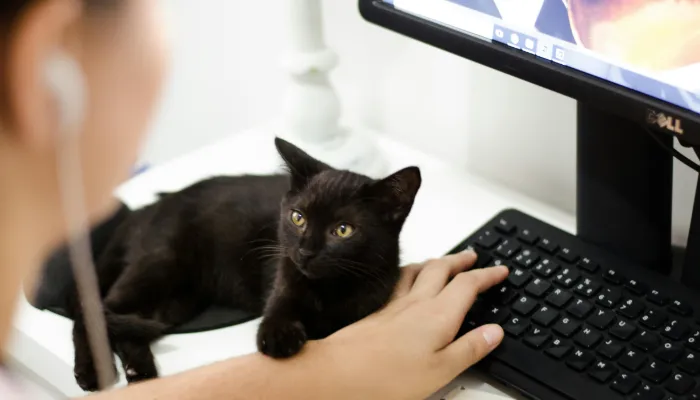A Cat Language Translator tool with a built-in AI is changing how cat owners communicate with their pets. Cats do not speak through human voices, they talk with meows, purrs, and their entire bodies.
The cat translator tries to figure out the secrets of a cat’s words and actions using sound analysis, AI apps, and human interpretation. Decoding feline needs will help strengthen your bond, pinpoint signs of stress, or simply add meaning to your relationship with your furry friend.

Cat Language Translator: A Basic Overview
Being able to interpret your cat’s language will help you build a stronger relationship with your pet. While cats don’t “speak” in human terms, they use sounds, posture, and actions to express themselves. A Cat Language Translator makes it possible to cut through the confusion so pet owners comprehend their cats better.
Why Understanding Cat Language Matters
- Improve your relationship with your pet.
- Spot stress or medical issues sooner rather than later.
- Help with training and behavior modification.
- Lessen chances of miscommunication and violent reactions.
A Cat Language Translator will help simplify and clarify all these cues and make communication with your feline friend more pleasurable. So, now that we know how cats communicate, let us take a look at translation tools on the next segment.
How Does A Cat Language Translator Work?
Cats communicate through various means – whether keeping quiet and using body language or actively meowing or purring – and it can be quite the puzzle trying to understand all of this. This is where a cat language translator online tries to help. This device utilizes technology and algorithms to interpret cat communication vocabulary and phrases. Let’s unpack the mechanisms as well as the technology needed behind these systems.
1. Cat Sound Translation Analysis
These translators work towards recognizing and analyzing cat sounds and coming up with a potential meaning.
- Cats meow, purr, and even chirp – each has a specific meaning behind them and conveys something.
- Translators focus mainly on sound’s pitch, frequency, and duration to categorize them.
- Some tools compare the pitches produced by the cat to the pre-understood vocabulary by AI.
Example Sound Meanings in Cats:
| Cat Sound | Possible Meaning |
|---|---|
| Short Meow | What? |
| Loud, Repetitive Meows | I’m really really hungry. |
| Purring | I feel so good. |
| Hissing or Growling | Stop right there! |
| Chirpping or Trilling | I’m super ready to play! |
2. AI Based Translation Applications
The ultimate hopes of building the cat language translator apps lies in the developments that have appeared in Artificial Intelligence (AI) and Machine Learning.
How They Operate:
- Collections of cat sounds are used to train AI algorithms which analyze and examine audio samples of cat sounds.
- The software associates the sounds with meanings already stored in the database.
- Apps such as these allow users to record the voice of their cat and then later expand the custom built words dictionary.
Some Of The More Used Cat AI Translators Are:
| Translator App | Features | Accuracy |
|---|---|---|
| “MeowTalk” | AI sound identification, custom cats profiles | Moderate |
| “Human-to-Cat Translator” | Cat sounds can be made from a computer to talk like a cat | Low |
| “Talk to Your Cat” App | Users can play sounds cats make and have cats react to them but not for the purpose of communication. | Low |
3. Human Interpretation of Cat Behavior
For now the greatest level of confidence in the understanding a cat can be achieved through determining observation and experience.
Important Cat Body Language Signals:
- Tail Position:
- Upright Tail: Content and Self Assured
- Puffed Tail: Panic or Annoyed
- Ears:
- Forward: Interested or Pleasantly Surprised
- Flattened: Indignant or Aggressive
- Eyes:
- Slow Blinking: Affection and Trust
- Dilated Pupils: Suspicion or Thrill
The ability to interprete cat behavior with sound analysis and AI technology, alongside human assistance leads to a wonderful but crude understanding of feline-human interactions.
That said, every owner or feline enthusiast must utilize their own affection and rapport with the pet for the correct comprehension.

Types of Cat Language Translator Apps & Devices
With contemporary technology, it is much easier to comprehend how your pet feline communicates. This is made possible through cat language translator apps and devices. These devices focus on decoding a cat’s speech, mannerisms, and feelings for better engagement with the pet owner. In this article, we look at different types of cat translator apps and platforms, their workings and how effective they are.
1. Mobile Apps for Cat Language Translation
Translation tools for feline apps are based on AI and employ algorithms that help ‘catify’ people’ to the pets by comprehending their cat meows and sounds. Here are some of the most prominent ones:
MeowTalk
- Created by an ex Amazon Alexa engineer.
- AI trained on a cat’s voice is used to identify and convert different cat meows.
- Further learning depending on the cat’s voice.
Human-to-Cat Translator
- Used for communicating with the pet by issuing pre-recorded cat sounds.
- Responses can even be solicited from cats.
- Perfect for engaging and playing with cats.
Talk to Your Cat App
- Employs a soundboard of traditional cat sounds.
- Aides in replication of kitty sounds for cat engagement.
- Amusing yet unscientific.
2. Wearable Cat Translator Devices
A few handfuls of modern wearable devices have been developed to perform spotting and translation of cat talk.
Meow Collar Translator
- The collar has a built-in sound recognition system.
- Potential meanings are displayed on the app.
- This is under development and is not widely available.
AI-Powered Pet Cameras
- Activities of the users’ cats like meows and movement are monitored.
- Alerts showing the mood for the cat (or the needs) in the moment are sent.
- Some models have automatic treat dispensers.
3. Smart Home Integration for Cat Communication
Smart home devices can now be integrated with cat language translator online by owners to monitor and understand their pets’ needs thanks to advancements in smart home technology.
AI Smart Speakers
- Some smart home assistants like Alexa or Google Home are able to hear cat sounds.
- While these devices don’t translate, they are able to capture and analyze the cat’s noises over time.
Interactive Smart Toys
- Some robotic toys that respond to cat sounds.
- Engages the cats while giving insight to their moods.
While devices and applications that serve as cat meow translator aids are in the making, these innovations provide a captivating window to feline speech. Though no device can accurately interpret a cat’s language, these innovations assist owners in comprehending their pets’ emotions, necessities, and actions more clearly.
Would you give a cat language translator a shot, or do you prefer interpreting your cat’s signs the usual way? Let us know what you think!

Why Use a Cat Language Translator?
Knowing what your cat feels and needs can help reinforce your relationship with their emotional well-being. Cat language translators assist in deciphering feline vocalizations and actions making it easier to communicate with cats. Efficient decoders aid in strengthening the bond shared between cats and humans.
1. Strengthens the Human-Cat Bond
Using a cat language translator will help you know what your cat friend is trying to say especially with their purrs, squeaks, and howls. Recognizing their vocal cues and body language means that an appropriate and considerate response will be given furthering the bond shared.
2. Facilitates Cat Training and Behavior Modification
By comprehending communication signals, training programs can be customized to strengthen positive conduct. It’s vital to identify these signals because they aid in the suspension of adverse behavior commonly exhibited by cats.
3. Helpful in Understanding a Cat’s Mood
Identifying A Need for Food or Water
Applications and devices are capable of recognizing specific meows which usually accompany a cat’s hunger or thirst. When doing so they are likely to ensure you do not ignore your cat’s requirements.
Understanding the Cat’s Emotional State
The cat language translator will be most helpful when your cat seems to be glum, overjoyed, or even annoyed. Sound and body movements can be analyzed to give out concerned conclusions.
4. Reduces Cat’s Stress and Anxiety
A kitty becomes stressed when cat’s needs or requirements are not understood. Cats do not like aerobic activity or a lot of movement, so giving them a stress-free environment would greatly benefit them. Using a translator can help owners know when to change their pet’s day-to-day life and surroundings to make them more comfortable.
5. A Fun and Engaging Way to Interact With Your Cat
Using a translator also has a more light-hearted side to it. It gives owners the chance to play with different ways of interacting with their cats as well as understanding their personality better.
While these translators may not be as accurate or effective as ideal translators, they surely provide a solution to interpreting most pet vocalization and emotion. The use of a translator can help the cat owners to make better relationships with their cats, address their needs more adequately, and make sure that the cats enjoy a stress-free life.
Do Cat Language Translators Actually Work?
Deciphering a cat’s purrs and meows is something we all yearn to achieve as pet owners. Many people wonder if devices and applications like cat language translator online really work in terms cat communication. Let’s take a look at their mechanism, accuracy, and the pros and cons of humans and cats using these tools.
How Do Cat Language Translators Work?
Most of these translators tell whether the cat is happy, aggressive, irritated, affectionate or sad depending on various emotions ranging from anger to love. These include:
1. AI-Powered Sound Analysis
Cat meow translator have an AI step that enables talking cats. It records the vocalizations of cats into different sections of data and formulates a dictionary of ordinary cat sounds. With thousands of data over time, the app can determine basic meanings.
2. Pre-Recorded Sound Libraries
There are other applications that allow users to communicate with their cats by using pre-recorded and generic sounds. Although a way to communicate with cats, these sounds might not represent how every cat communicates to their respective owners.
3. Human Interpretation Assistance
A different type of human to cat translator devices allows for user tagging where owners manually tag their feline companions’ sounds while creating a personalized feline vocal dictionary. Over time, this builds a personalized dictionary of a cat’s unique vocal patterns.
Do They Actually Work?
Though cat language translators do sound fun while not offering accurate results, they do provide entertainment value.
Here is the reason:
1. Cats Have Individual Ways of Interacting
Different from human languages, the sounds made by cats are not international. Every cat can have a special way of meowing when it wants attention, food or to play. This complexity makes AI translation very hard.
2. Cats Also have Culture
Cats articulate themselves through physical movement, vocalization, and active behavior. For instance, consider these circumstances in which a single meow can have multiple meanings:
- Position of the cat’s body and tail.
- The setting in which they are (before eating or after during playing).
- The association the cat shares with the owner.
Most devices that are capable of translating words into speech aim primarily at mechanical features, which makes them inaccurate because they focus on a simpler context.
3. Limitations on Science
Scientific efforts have diabled common speaking characteristics of a cat, but science does not know how to speak with a cat and needs lots of formulators to put it together. Most of the advanced translatior work using cameras perform vexillological study of cats.
Are Cat Language Translators Worth Trying?
Certainly, but certain parts must be controlled! Definitely, they can be fun and help individuals pay more attention on how to listen to cats. But like all other inventions, they can not be depended on for accuracy. The way to communicate with your cat is interacting, looking at, and forming a bond with them.
Although a cat language translator is unlikely to help you speak “cat”, it can help you understand your pet a little better!
Conclusion
Despite not being 100% accurate, Cat Language Translator makes a great effort towards understanding the language of cats. These AI tools can only decode trivial sound forms. To really get to know your cat, you are required to observe and build a relationship with the animal. For every cat owner out there, this means that rather than viewing the pet as a digital object, pay attention to them and build a relationship that genuinely captures their heart.
